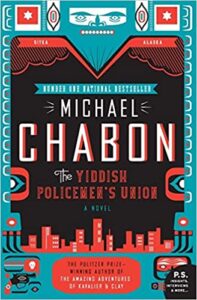By Michael Chabon
 If Raymond Chandler had sat down with Isaac Bashevis Singer over a bottle of schnapps, they might have produced THE YIDDISH POLICEMEN’S UNION.
If Raymond Chandler had sat down with Isaac Bashevis Singer over a bottle of schnapps, they might have produced THE YIDDISH POLICEMEN’S UNION.
THE YIDDISH POLICEMEN’S UNION combines a noir murder mystery with Jewish messianic beliefs in a “what if . . . “ context that springs from an actual historical fact.
Chabon’s starting point is the 1940 Slattery Report that recommended that Alaska be used for temporarily resettling European Jews fleeing the Nazis. Ultimately, Alaska Territory Delegate to the U.S. House of Representatives Anthony J. Dimond prevented a vote on the recommendation from ever taking place.
In Chabon’s book, the Jews of Alaska are within months of losing their temporary sanctuary, which will rejoin the United States. The State of Israel had been established in 1948 but was destroyed within three months by an Arab-Israeli war. The U.S. president believes in a divine mandate for the Jews to reclaim Israel once again.
The main character, Meyer Landsman, is an alcoholic homicide detective for the Sitka police department. He and his wife, Bina Gelbfish (also a police officer), have separated because Meyer is unable to live with the guilt of their decision to abort their unborn child Django due to a tragic genetic problem. Meyer’s father, Isador Landsman, was a Holocaust survivor and chess grandmaster. His sister, Naomi, a bush pilot, died in a suspicious plane crash the year before.
Meyer is called in on the murder of a fellow resident of the Hotel Zamenhoff. The victim, Emmanuel Lasker, has been shot execution-style with tools for shooting up heroin beside him, along with a chessboard in mid-game and a book of famous chess games.
Investigation reveals the victim is actually Mendel Shpilman, son of a Hasidic rebbe, who had disowned him.
Meyer’s wife, Bina, is promoted to commander of their unit. The unit is charged with speedily cleaning up its docket of unsolved cases before Alaska reverts to American control. Meyer is involved in a shootout that leads to his suspension from active duty. He unofficially pursues the Shpilman case on the strength of a ragged Yiddish Policemen’s Union ID card.
As Meyer drills into the issue of who killed Shpilman and why, the implications of his discoveries grow into dramatic international proportions
While THE YIDDISH POLICEMEN’S UNION requires consciously suspending disbelief, it is riveting, poignant and hilarious. Yiddish speakers and chess mavens mingle with Tinglit Native Americans. Characters reach for their cell phones made by Shoyfer, in a wink to the shofars that call Jews to repentance on Yom Kippur. Cops and bad guys alike carry guns referred to as shaloms — a “piece” in detective books or perhaps a peace-maker.
Chabon’s Pulitzer Prize-winning THE AMAZING ADVENTURES OF KAVALIER & CLAY is a more factually realistic tale of Jewish cartoonists during the 1930s and World War II years.
THE YIDDISH POLICEMAN’S UNION is a celebration of imagination and yiddishkeit. Any reader with a taste for alternate realities and paradox will have much to enjoy in THE YIDDISH POLICEMEN’S UNION.
The Author: Michael Chabon (1963 – )
Michael Chabon published his first novel, THE MYSTERIES OF PITTSBURG (1988), when he was 25. The book was written as his master’s thesis at the University of California, Irvine (UCI). His third novel, THE AMAZING ADVENTURES OF KAVALIER & CLAY (2000) won the 2001 Pulitzer Prize for Fiction.
THE YIDDISH POLICEMEN’S UNION won the Hugo, Sidewise, Nebula and Ignotus awards.
In addition to his novels, he has published screenplays, children’s books, comics and newspaper serials.
Born in Washington, D.C., Chabon’s parents were lawyers; his father was also a physician. Michael knew he wanted to be a writer from the age of 10 when he wrote his first short story for a class assignment. After his parents divorced when he was 11, he divided his time between Pittsburgh and Columbia, MD.
He earned a bachelor’s degree from the University of Pittsburgh and a master of fine arts in creative writing from the University of California, Irivine.


